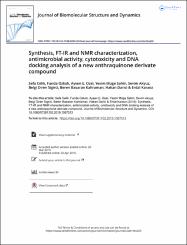Synthesis, FT-IR and NMR characterization, antimicrobial activity, cytotoxicity and DNA docking analysis of a new anthraquinone derivate compound

View/
Access
info:eu-repo/semantics/openAccessDate
2019-03Author
Çelik, SefaÖzkök, Funda
Özel, Ayşen E.
Şahin, Yeşim Müge
Akyüz, Sevim
Sığırcı, Belgi Diren
Kahraman, Beren Basaran
Darıcı, Hakan
Karaöz, Erdal
Metadata
Show full item recordCitation
Celik, S., Ozkok, F., Ozel, A. E., Sahin, Y. M., Akyuz, S., Sigirci, B. D., . . . Karaoz, E. Synthesis, FT-IR and NMR characterization, antimicrobial activity, cytotoxicity and DNA docking analysis of a new anthraquinone derivate compound. Journal of Biomolecular Structure & Dynamics, 15. doi:10.1080/07391102.2019.1587513Abstract
A new anthraquinone [1-(2-Aminoethyl)piperazinyl-9,10-dioxo-anthraquinone] derivative was synthesized and characterized by density functional theory (DFT) calculations, experimental and theoretical vibrational spectroscopy and NMR techniques. The most stable molecular structure of the title molecule was determined by DFT B3LYP method with 6-31++G(d,p) and 6-311++G(d,p) basis sets. The fundamental vibrational wavenumbers, IR and Raman intensities for the optimized structure of the investigated molecule were calculated and compared with the experimental vibrational spectra. The vibrational assignment of the molecule was done using the potential energy distribution analysis. The molecular electrostatic potential (MEP), highest occupied molecular orbital (HOMO) and lowest occupied molecular orbital (LUMO) were also calculated. The antibacterial activities of the new anthraquinone derivative against Gram-positive and Gram-negative bacteria were determined, and it was shown that the highest effectiveness was against Staphylococcus aureus and S. epidermidis while no activity was against Gram-negative bacteria. Moreover, the antimycotic activity of the title compound was examined and the cytotoxicity of anthraquinone derivate was determined. In order to find the possible inhibitory activity of the title compound, molecular docking of the molecule was carried out against DNA. The results indicated that the mentioned compound has a good binding affinity to interact with the DC3, DG4, DA5, DC21 and DC23 residues of DNA via the intermolecular hydrogen bonds.

















